Mormon Ain't Nothing but Murder Misspelled
The Crusaders #18: The Enchanter
I can still vividly recall the first time I read a comic by Jack T. Chick. It was one of his famous free tracts, left on a bench at a local pizza place. The story concerned a burly trucker telling someone something about Jesus, somehow, to great effect. Er, the sensation is what's vivid, not the plot. It was a funny comic, and my brother and I laughed and laughed, and possibly drew something in the little blank spaces in the back where you're supposed to affirm your acceptance of Jesus Christ as your personal Savior.
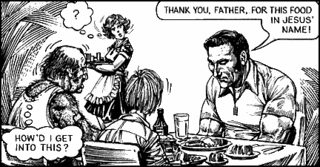
The second time I ran across a Chick tract, it on a summer vacation with my family, outside our hotel. I don't remember the contents of that one at all, since my mother got ahold of it once we were in our room, read a bit, and mysteriously demanded I take it outside and throw it away. I naturally started flipping through the little comic the second I was behind the door, but this was a vital enough mission that Mom was keeping watch - it must have been one of Chick's anti-Catholic specials, because I got a sharp talking to over my disobedience. "But mom, they're funny!" I remember my brother pleading, but he was preaching to the wrong choir.
"Those comics say bad things about our religion," Mom declared. And for years after, merely spotting a Chick tract filled me with trepidation. They were scary comics, because my mother disliked them so. They were bad.
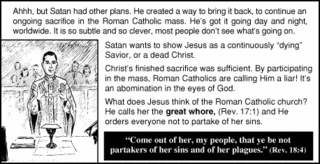
So, it probably goes without saying that I've read roughly one million Jack T. Chick comics by now, since there's no better way to fascinate a kid with something than to tell them it's bad, especially if that something is free. My brother just picked a few up the other week. Who can resist? Giveaways are part of what makes Chick an alluring figure - born over 80 years ago and a veteran of WWII, the artist is temporally of the 'Golden Age' generation of comic book artists, although his confrontational subject matter and alternative distribution system tend to mark him as more a proto-underground figure. Hell, taking comics for free is the hot thing these days, so maybe Chick is only now seeing his time truly arrive - he's got a ton of stuff online himself.
But I'm a seasoned enough Chick reader to know there's more to him than just giveaways. He's a publisher of prose books. A distributor of videos. He's even a filmmaker, having conceived and written 2003's The Light of the World, a narrated traipse through 360 oil paintings by his longtime colleague, Fred Carter.
And it's with Carter that Chick created a full-blown, full-color, pamphlet-format you-gonna-buy-that-buddy-this-ain't-a-library comic book series. Debuting in 1974, The Crusaders initially followed the adventures of Tim Clark and Jim Carter -- possibly virile young action versions of Chick and (Fred) Carter themselves -- as they zipped around battling Satanism, Communism, suicide, evolution (Chick was on that shit in '76, slowpokes!), rock 'n roll, and other top-tier menaces to Christian living.
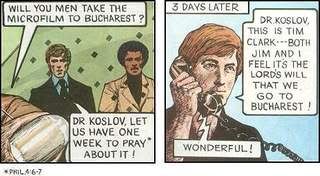
The thrills would often pause at some point for an illustrated history of the wickedness at hand, and the store-bought pamphlet format allowed for all the vivid imagery and bloody mayhem needed to keep the eyes open, albeit for the purposes of saving souls. As Robert B. Fowler summarized in his 2001 book The World of Chick?, regarding issue #9: "Darlene and Jeff are living in sin. Two serial killers randomly choose Darlene as their next lucky winner, but the Crusaders save her. And tell her she is going to Hell."
And then, with issue #12, Tim 'n Jim began spending what would turn out to be roughly 150 pages standing around and listening to the story of one Dr. Alberto Rivera, an alleged Catholic insider willing to detail, at whatever length necessary, the nefarious history of that diabolical empire of devilry.
In short, the Catholic Church -- and especially its subversive kill squad, the Jesuits -- are behind just about everything, ever. Alberto continued to talk until issue #17, published in 1988, after which the re-christened Alberto series went off to Rivera's wife's own AIC Publications for another issue or two. The Crusaders slept.
Until:
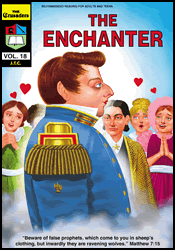
Yep, it's 20 years later, and the "classic" Crusaders are back. I haven't the slightest idea why Chick Publications is opting to put out a new pamphlet-format comic now; maybe there's a plan for Christian bookstore distribution? I certainly don't think Diamond's picked it up, and (perhaps tellingly) there's not even a price on the cover. But for $2.25, you can get it straight from Chick; with 32 color pages of story, at least the man still knows value.
A million questions are probably blasting through the heads of Crusaders fans right now, so the first thing I need to mention is that I do believe the old team is back together.
Just like in Golgo 13, no credits are provided for writing or art, but the writing certainly has the classic Jack T. Chick flavor, and the visuals do appear to be the work of Fred Carter, although he's either taught himself Photoshop or taken on some coloring/digital effects assistance - the Carter skill with caricature is still evident from the lines, but everything is slathered with shiny hues and digital textures (one guy's Hawaiian shirt is hypnotic in this regard).
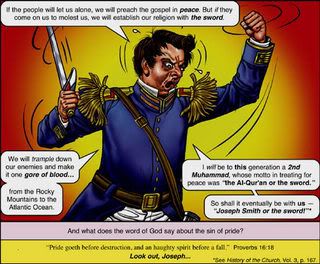
Figures sometimes look stiffly pasted against digital backgrounds, including a few panels with the drawn characters standing against photographic foliage. It's often garish, and lacking the graphic aplomb of his best work.
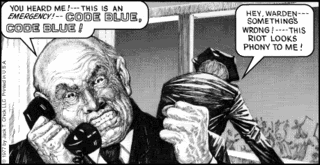

But the force of Chick's writing really helps propel this thing; he's in full-tilt attack mode, and I felt the flutter of stomach nerves just beholding it.
The topic is Mormons; it will come as no surprise that they are revealed to 'drool,' whereas accepting Christ as your personal savior is all that can 'rule.' The tale begins with good wife Darlene -- not the one from the serial killer issue, but drawn in Carter's emphatic, Quitelyesque chubby-cheeked manner -- arriving home to a bloody murder scene, starring her recently post-Mormon husband.
Inside, the town's thin, bald sheriff sends a strapping "Gentile" beat officer to work crowd control outside after he dares suggest it might be murder rather than suicide; before long, the sweaty local bishop is on location, plotting a cover-up. When Darlene finally manages to see the body ("only the undamaged part of his face"), she's castigated for her somewhat tactless suggestion to the local Mormon officials that the church totally murdered her husband for leaving them. The snark begins as soon as she's gone:
"Filthy Gentile. She corrupted Jake. Good riddance!"
"At least his soul is saved now, thanks to our Avenging Angels."
"Yes, God bless 'em!"
Dangerous-looking bald and pointy-bearded men keep an eye on Darlene as she enters a phone booth; the church froze hers and Jake's bank account and took their home, but luckily she still has the quarters to call... The Crusaders! At their day jobs. Where I guess they sit in adjacent cubes.
As seemingly the entire crazy town gathers outside with bats, Darlene begs Tim 'n Jim to send money, letting them know she's extra scared. Our Heroes spring into action, kneeling down in prayer (Tim's elbows planted manfully into his computer chair) and begging God's protection of sweet Darlene. In perhaps the most lethargic display of divine intervention in 21st century comics thus far, an old dude then shows up and tells the brethren that Darlene ain't on the list (OF MURDER). In the midst of this miraculous scene, a slovenly type leers at the scared woman, and cuts loose with a "Haw Haw," because there's fans that need servicing. Jack T. Chick knows it.
Um, then the Crusaders send Darlene money and she leaves town, and that's it for the adventure segment of the comic.

The remaining 26 pages see Tim 'n Jim sitting down with David Franks, ex-Mormon, for a nice history lesson on what the church is all about. I was reminded a bit of an NPR interview I heard the other day. It was with an evangelical minister, who spoke of the difficulties in reconciling the values of Mormon presidential candidate Mitt Romney with the perspective many congregation members (and indeed, leaders) have of Mormanism as a cult.
Jack T. Chick doesn't call it a cult.
Jack T. Chick has establishing scenes set in Hell. With some great monster designs by Carter - the devil that vouches for Joseph Smith is bony and green, with heavy dribbles of flesh waving like gelatin raindrops from his belly and arms, bone horns set above his nose and curling around his ears, with fat purple eyes peering out from the hollowed bases. Satan himself is decked out in a sweet robe, looking and acting like Skeletor ("Of course I will, you idiot!"), no doubt already anticipating the taste of Spidey's wedding cake.
So anyway, we leard that Mormons are awful, in much the way that every religion is ultimately awful in the world of Jack T. Chick. Sin piles atop sin, past the point of dryness, with only the occasional panel of a black-robed figure confronting Joseph Smith around to break things up. I confess that many readers may get bored. But I suppose I'm too easy a mark for Chick - he scared me as a kid, and thrilled me later with his history-spanning tales of Catholics as the demons behind seemingly all the world's strife, a truly grand, era-spanning conspiracy, too wild to stay away from, starring my friends and family and neighbors.
I suspect this work may have some of the same power on young Mormons (if they find it, that is - this isn't meant to be given away, and its aim is information to the True Believer rather than conversion). It necessarily lacks in scope, though not emphasis. When Sampson Avard shows up to form the Danites, Chick knows a panel of Adolph Hitler and his SS will be in order, but only after Jim remarks on the similarities between the comic's opening murder and the Danites' vigilante activities (nudge nudge). Yet Chick is a bit too broad a thinker to let his work rest in such fetid water; he stretches his analysis outward, to compare Smith and Mohammed (you bet your ass his face is shown), to explore Masonic murder, and ultimately... well, let's just say it wouldn't be Chick without a little Jesuit revelation at the end.
"So, it appears Dr. Rivera was right again!" exclaims Tim, hooking this shit together like Final Crisis. In these moments, beyond my personal interests, Chick's chronicle adopts the character of nearly cosmic world-building, although I think he'd call it less architecture than cartography. It is redolent with the accumulation of gestures and tropes from decades of creation with as much freedom as a pair of cartoonists can be blessed with. If Lewis Trondheim wondered aloud where a cartoonist might go as he ages, Chick and Carter suggest an answer risen from outside any mainstream's oft-pilloried grip.
Addition. Skyless addition in the accidental metaphor of global conspiracy as a yearning for certainty in the immaterial. The faceless God is in the back of the book. So's the blank space to draw in. A line for the date, in case you're asked later.
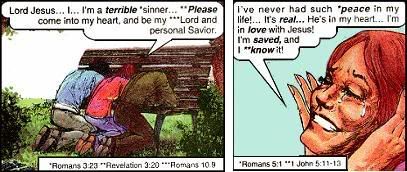
For Chick's heroes, the end is always assured.
I can still vividly recall the first time I read a comic by Jack T. Chick. It was one of his famous free tracts, left on a bench at a local pizza place. The story concerned a burly trucker telling someone something about Jesus, somehow, to great effect. Er, the sensation is what's vivid, not the plot. It was a funny comic, and my brother and I laughed and laughed, and possibly drew something in the little blank spaces in the back where you're supposed to affirm your acceptance of Jesus Christ as your personal Savior.

The second time I ran across a Chick tract, it on a summer vacation with my family, outside our hotel. I don't remember the contents of that one at all, since my mother got ahold of it once we were in our room, read a bit, and mysteriously demanded I take it outside and throw it away. I naturally started flipping through the little comic the second I was behind the door, but this was a vital enough mission that Mom was keeping watch - it must have been one of Chick's anti-Catholic specials, because I got a sharp talking to over my disobedience. "But mom, they're funny!" I remember my brother pleading, but he was preaching to the wrong choir.
"Those comics say bad things about our religion," Mom declared. And for years after, merely spotting a Chick tract filled me with trepidation. They were scary comics, because my mother disliked them so. They were bad.

So, it probably goes without saying that I've read roughly one million Jack T. Chick comics by now, since there's no better way to fascinate a kid with something than to tell them it's bad, especially if that something is free. My brother just picked a few up the other week. Who can resist? Giveaways are part of what makes Chick an alluring figure - born over 80 years ago and a veteran of WWII, the artist is temporally of the 'Golden Age' generation of comic book artists, although his confrontational subject matter and alternative distribution system tend to mark him as more a proto-underground figure. Hell, taking comics for free is the hot thing these days, so maybe Chick is only now seeing his time truly arrive - he's got a ton of stuff online himself.
But I'm a seasoned enough Chick reader to know there's more to him than just giveaways. He's a publisher of prose books. A distributor of videos. He's even a filmmaker, having conceived and written 2003's The Light of the World, a narrated traipse through 360 oil paintings by his longtime colleague, Fred Carter.
And it's with Carter that Chick created a full-blown, full-color, pamphlet-format you-gonna-buy-that-buddy-this-ain't-a-library comic book series. Debuting in 1974, The Crusaders initially followed the adventures of Tim Clark and Jim Carter -- possibly virile young action versions of Chick and (Fred) Carter themselves -- as they zipped around battling Satanism, Communism, suicide, evolution (Chick was on that shit in '76, slowpokes!), rock 'n roll, and other top-tier menaces to Christian living.

The thrills would often pause at some point for an illustrated history of the wickedness at hand, and the store-bought pamphlet format allowed for all the vivid imagery and bloody mayhem needed to keep the eyes open, albeit for the purposes of saving souls. As Robert B. Fowler summarized in his 2001 book The World of Chick?, regarding issue #9: "Darlene and Jeff are living in sin. Two serial killers randomly choose Darlene as their next lucky winner, but the Crusaders save her. And tell her she is going to Hell."
And then, with issue #12, Tim 'n Jim began spending what would turn out to be roughly 150 pages standing around and listening to the story of one Dr. Alberto Rivera, an alleged Catholic insider willing to detail, at whatever length necessary, the nefarious history of that diabolical empire of devilry.
In short, the Catholic Church -- and especially its subversive kill squad, the Jesuits -- are behind just about everything, ever. Alberto continued to talk until issue #17, published in 1988, after which the re-christened Alberto series went off to Rivera's wife's own AIC Publications for another issue or two. The Crusaders slept.
Until:

Yep, it's 20 years later, and the "classic" Crusaders are back. I haven't the slightest idea why Chick Publications is opting to put out a new pamphlet-format comic now; maybe there's a plan for Christian bookstore distribution? I certainly don't think Diamond's picked it up, and (perhaps tellingly) there's not even a price on the cover. But for $2.25, you can get it straight from Chick; with 32 color pages of story, at least the man still knows value.
A million questions are probably blasting through the heads of Crusaders fans right now, so the first thing I need to mention is that I do believe the old team is back together.
Just like in Golgo 13, no credits are provided for writing or art, but the writing certainly has the classic Jack T. Chick flavor, and the visuals do appear to be the work of Fred Carter, although he's either taught himself Photoshop or taken on some coloring/digital effects assistance - the Carter skill with caricature is still evident from the lines, but everything is slathered with shiny hues and digital textures (one guy's Hawaiian shirt is hypnotic in this regard).

Figures sometimes look stiffly pasted against digital backgrounds, including a few panels with the drawn characters standing against photographic foliage. It's often garish, and lacking the graphic aplomb of his best work.


But the force of Chick's writing really helps propel this thing; he's in full-tilt attack mode, and I felt the flutter of stomach nerves just beholding it.
The topic is Mormons; it will come as no surprise that they are revealed to 'drool,' whereas accepting Christ as your personal savior is all that can 'rule.' The tale begins with good wife Darlene -- not the one from the serial killer issue, but drawn in Carter's emphatic, Quitelyesque chubby-cheeked manner -- arriving home to a bloody murder scene, starring her recently post-Mormon husband.
Inside, the town's thin, bald sheriff sends a strapping "Gentile" beat officer to work crowd control outside after he dares suggest it might be murder rather than suicide; before long, the sweaty local bishop is on location, plotting a cover-up. When Darlene finally manages to see the body ("only the undamaged part of his face"), she's castigated for her somewhat tactless suggestion to the local Mormon officials that the church totally murdered her husband for leaving them. The snark begins as soon as she's gone:
"Filthy Gentile. She corrupted Jake. Good riddance!"
"At least his soul is saved now, thanks to our Avenging Angels."
"Yes, God bless 'em!"
Dangerous-looking bald and pointy-bearded men keep an eye on Darlene as she enters a phone booth; the church froze hers and Jake's bank account and took their home, but luckily she still has the quarters to call... The Crusaders! At their day jobs. Where I guess they sit in adjacent cubes.
As seemingly the entire crazy town gathers outside with bats, Darlene begs Tim 'n Jim to send money, letting them know she's extra scared. Our Heroes spring into action, kneeling down in prayer (Tim's elbows planted manfully into his computer chair) and begging God's protection of sweet Darlene. In perhaps the most lethargic display of divine intervention in 21st century comics thus far, an old dude then shows up and tells the brethren that Darlene ain't on the list (OF MURDER). In the midst of this miraculous scene, a slovenly type leers at the scared woman, and cuts loose with a "Haw Haw," because there's fans that need servicing. Jack T. Chick knows it.
Um, then the Crusaders send Darlene money and she leaves town, and that's it for the adventure segment of the comic.

The remaining 26 pages see Tim 'n Jim sitting down with David Franks, ex-Mormon, for a nice history lesson on what the church is all about. I was reminded a bit of an NPR interview I heard the other day. It was with an evangelical minister, who spoke of the difficulties in reconciling the values of Mormon presidential candidate Mitt Romney with the perspective many congregation members (and indeed, leaders) have of Mormanism as a cult.
Jack T. Chick doesn't call it a cult.
Jack T. Chick has establishing scenes set in Hell. With some great monster designs by Carter - the devil that vouches for Joseph Smith is bony and green, with heavy dribbles of flesh waving like gelatin raindrops from his belly and arms, bone horns set above his nose and curling around his ears, with fat purple eyes peering out from the hollowed bases. Satan himself is decked out in a sweet robe, looking and acting like Skeletor ("Of course I will, you idiot!"), no doubt already anticipating the taste of Spidey's wedding cake.
So anyway, we leard that Mormons are awful, in much the way that every religion is ultimately awful in the world of Jack T. Chick. Sin piles atop sin, past the point of dryness, with only the occasional panel of a black-robed figure confronting Joseph Smith around to break things up. I confess that many readers may get bored. But I suppose I'm too easy a mark for Chick - he scared me as a kid, and thrilled me later with his history-spanning tales of Catholics as the demons behind seemingly all the world's strife, a truly grand, era-spanning conspiracy, too wild to stay away from, starring my friends and family and neighbors.
I suspect this work may have some of the same power on young Mormons (if they find it, that is - this isn't meant to be given away, and its aim is information to the True Believer rather than conversion). It necessarily lacks in scope, though not emphasis. When Sampson Avard shows up to form the Danites, Chick knows a panel of Adolph Hitler and his SS will be in order, but only after Jim remarks on the similarities between the comic's opening murder and the Danites' vigilante activities (nudge nudge). Yet Chick is a bit too broad a thinker to let his work rest in such fetid water; he stretches his analysis outward, to compare Smith and Mohammed (you bet your ass his face is shown), to explore Masonic murder, and ultimately... well, let's just say it wouldn't be Chick without a little Jesuit revelation at the end.
"So, it appears Dr. Rivera was right again!" exclaims Tim, hooking this shit together like Final Crisis. In these moments, beyond my personal interests, Chick's chronicle adopts the character of nearly cosmic world-building, although I think he'd call it less architecture than cartography. It is redolent with the accumulation of gestures and tropes from decades of creation with as much freedom as a pair of cartoonists can be blessed with. If Lewis Trondheim wondered aloud where a cartoonist might go as he ages, Chick and Carter suggest an answer risen from outside any mainstream's oft-pilloried grip.
Addition. Skyless addition in the accidental metaphor of global conspiracy as a yearning for certainty in the immaterial. The faceless God is in the back of the book. So's the blank space to draw in. A line for the date, in case you're asked later.

For Chick's heroes, the end is always assured.

<< Home